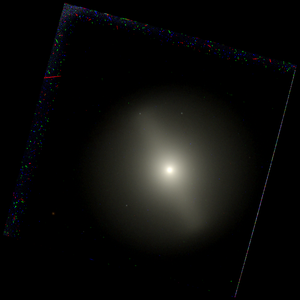NGC 1543
| Galaxy NGC 1543 |
|
|---|---|

|
|
| Photo from the Hubble Space Telescope | |
| AladinLite | |
| Constellation | network |
|
Position equinox : J2000.0 , epoch : J2000.0 |
|
| Right ascension | 04 h 12 m 43.25 s |
| declination | -57 ° 44 ′ 16.7 ″ |
| Appearance | |
| Morphological type | (R) SB (l) 0 ^ 0 |
| Brightness (visual) | 10.3 mag |
| Brightness (B-band) | 11.3 mag |
| Angular expansion | 3.8 ′ × 2.8 ′ |
| Position angle | 93 ° |
| Surface brightness | 12.7 mag / arcmin² |
| Physical data | |
| Affiliation |
Dorado group SSRS group 13 NGC 1553 group LGG 112 |
| Redshift | 0.003922 ± 0.000024 |
| Radial velocity | 1176 ± 7 km / s |
|
Stroke distance v rad / H 0 |
(45 ± 3) x 10 6 ly (13.7 ± 1.0) Mpc |
| history | |
| discovery | James Dunlop |
| Discovery date | November 5, 1826 |
| Catalog names | |
| NGC 1543 • PGC 14659 • ESO 118-010 • IRAS 04117-5751 • 2MASX J04124324-5744166 • SGC 041144-5751.8 • GC 830 • h 2627 • GALEX ASC J041243.10-574416.9 • LDCE 328 NED004 • WISEA J041243.17-574416.3 | |
NGC 1543 is a lenticular galaxy of the Hubble type SB0 in the constellation Reticulum in the southern sky . It is an estimated 45 million light years from the Milky Way and about 55,000 light years in diameter. Together with four other galaxies, it forms the NGC 1553 group ( LGG 112 ).
In the same area of the sky is u. a. the galaxy IC 2049 .
The object was discovered on November 5, 1826 by James Dunlop using a 9-inch reflector.
Web links
Commons : NGC 1543 - collection of images, videos, and audio files
